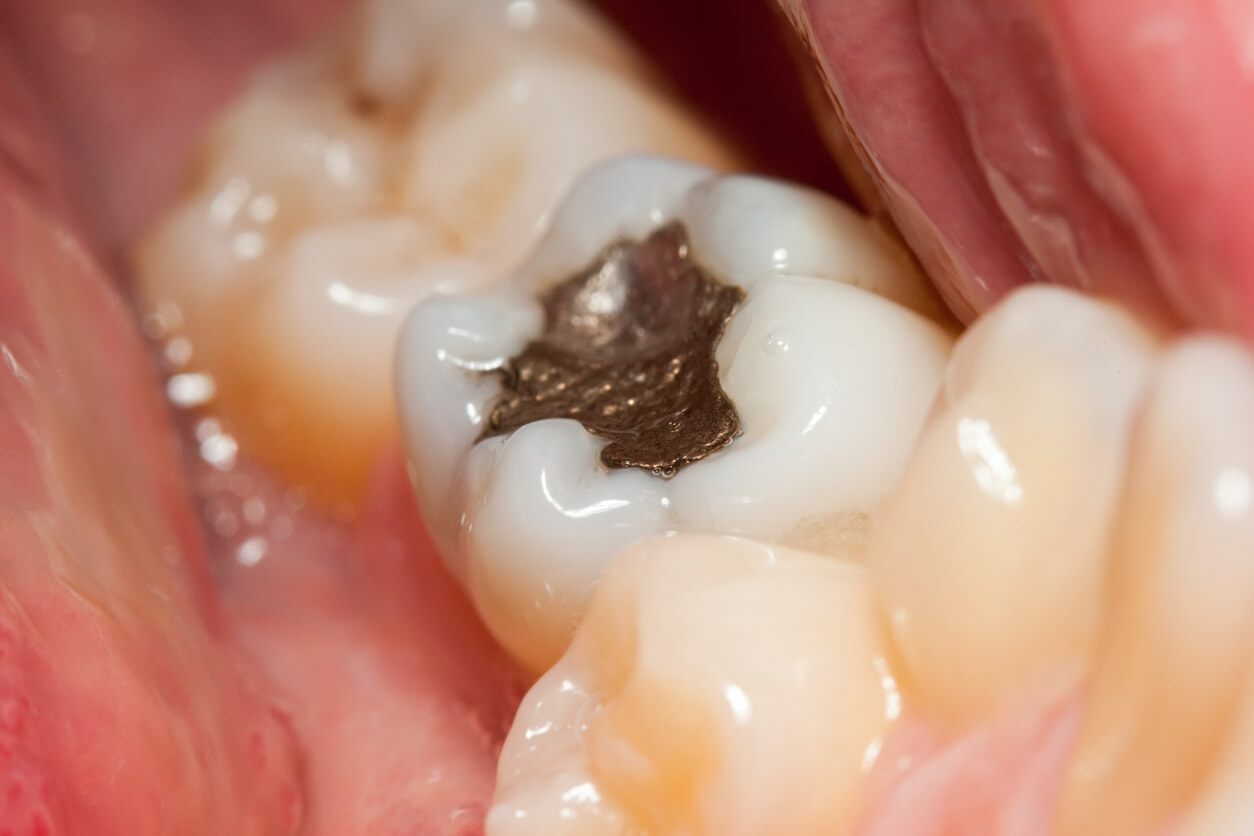Types of Dental Fillings for Children


Written and verified by the dentist Vanesa Evangelina Buffa
Cavities and fractures are frequent situations in childhood that affect the integrity of children’s teeth. Different types of dental fillings are used to treat damaged teeth in children in order to restore their oral health. They’re special materials that are placed inside the broken teeth to restore their shape and function. In addition, they prevent cavities from continuing and destroying more tissue.
Pediatric dentists are in charge of performing dental filling treatments in children. However, you should know that there are different types of materials to fill cavities in teeth. Here, we’ll tell you about them in detail.
What is a dental filling?
Dental fillings in children are a dental treatment that removes decayed or damaged tissue and replaces it with an artificial material. This allows the affected tooth to regain its lost shape and function. The techniques and materials used depend on the amount of tissue affected, the condition of the other elements, the age of the child, and their cooperation in the dental office.
When cleaning the tooth and removing decay, manual techniques may be used. Sometimes it’s possible to perform procedures that don’t require the use of anesthesia. In any case, when the depth of the lesion is very large or the child accepts the placement of anesthetic, the area is numbed so that there’s no pain. If the case warrants it, the use of anesthesia can be combined with sedation techniques.
Once the tissue is removed, the cavity is filled with a soft material. This is molded into a tooth-like shape and then hardened. In addition, if cavities aren’t treated in a timely manner, the disease will run its course. This can lead to pain, severe infection, and total destruction of the tooth. This affects the functions of the mouth, the aesthetics of the smile, the development of the bite, and the quality of life of the child.
Learn about the types of dental fillings for children
Dental fillings fill the cavities of damaged teeth. You should know that there are different types of dental fillings available to restore the anatomy of the teeth. Here are the main ones.

Amalgam
Amalgam is one of the oldest and most popular filling materials in dentistry. Today, it’s still used for some dental fillings in children. However, the presence of mercury, one of its components, has led to its discontinuation in some places because it’s a toxic and polluting element.
There’s no convincing evidence that amalgam dental restorations cause harm to health. The U.S. Food and Drug Administration (FDA) considers the levels of mercury in these types of restorations to be safe for the general population. However, in some countries, these dental fillings are prohibited by specific laws.
Characteristics of amalgam dental fillings in children
Amalgam dental fillings are bright silver in color. As they’re evident to the naked eye, they’re only used in the posterior sector of the mouth. They’re applied in the molars, as it’s a material capable of adequately withstanding masticatory forces. It’s used in children who can’t keep their mouths open for long periods of time.
A disadvantage of amalgam fillings is that they can stain and darken the fixed tooth. This gray shade affects the appearance of the tooth. Also, it can expand and contract with temperature changes, causing fractures and microleakage if it’s not well adapted. Some children who suffer from metal allergies may have reactions to the placement of an amalgam.
Composite resin dental fillings in children
Composite resins, also called composites, are materials used to make dental fillings. They’re made up of a combination of ceramic and plastic. They’re placed over the cavities of the teeth in a soft state. Then, they harden completely in a matter of seconds when exposed to a halogen light beam. Because of this property, they’re called light-cure fillings.
It’s possible to choose from a wide range of shades and opt for the one that most closely resembles the element to be restored. This way, the fillings are almost imperceptible to the naked eye. However, thanks to improvements in dental materials, resins can also be used in the posterior area and resist masticatory forces.
When applying this type of filling, less wear is required on the tooth compared to amalgam. In addition, a negative aspect of resin dental fillings is their cost. Compared to the other options, it’s the most expensive material.

Glass ionomer dental fillings
Glass ionomer dental fillings are an excellent alternative for fixing children’s teeth. This material has the advantage that, in addition to restoring the tooth, it releases fluoride. In addition, they’re tooth-colored materials, since they’re made of a mixture of acrylics and glass powder. Also, they’re easy and quick to place and harden in the presence of humidity.
Their duration isn’t as long, around 5 years. However, this time is enough to protect the teeth until the child is able to tolerate a more complex treatment. In general, they’re of choice in patients at high risk of cavities and in young children.
Medicated pastes or sedative fillings
There are special pastes that can be placed as fillings in the teeth to reduce pain. When cavity lesions are deep and the dental pulp causes sensitivity, these materials help to alleviate discomfort. In addition, by plugging the cavity, the chances of saliva and bacteria seeping into the deeper areas are reduced. This prevents the pulp from becoming irritated or the holes in the broken pieces from accumulating germs.
One of the most common sedation pastes is zinc oxide-eugenol. This is prepared by mixing powder with liquid to obtain a putty that’s placed inside the tooth and hardens. Its coloration is white and its texture is slightly porous. This means that over time, it can stain and wear away with saliva. Vitreous ionomers can also be used as a sedating filling.
Most of the time, these materials are placed directly into the tooth without using a turbine. The tooth is cleaned with hand instruments and then the paste that fills the tooth is placed on the area. The duration of these arrangements ranges from 3 to 6 months. They also require regular checkups to make sure the paste is still in place and serving its purpose.
The best option for your little one
Pediatric dentists have several options for dental fillings to place in children. The best option for restoring your child’s teeth depends on many factors. The professional will choose the most appropriate one to restore the lost health to your child’s smile.
Cavities and fractures are frequent situations in childhood that affect the integrity of children’s teeth. Different types of dental fillings are used to treat damaged teeth in children in order to restore their oral health. They’re special materials that are placed inside the broken teeth to restore their shape and function. In addition, they prevent cavities from continuing and destroying more tissue.
Pediatric dentists are in charge of performing dental filling treatments in children. However, you should know that there are different types of materials to fill cavities in teeth. Here, we’ll tell you about them in detail.
What is a dental filling?
Dental fillings in children are a dental treatment that removes decayed or damaged tissue and replaces it with an artificial material. This allows the affected tooth to regain its lost shape and function. The techniques and materials used depend on the amount of tissue affected, the condition of the other elements, the age of the child, and their cooperation in the dental office.
When cleaning the tooth and removing decay, manual techniques may be used. Sometimes it’s possible to perform procedures that don’t require the use of anesthesia. In any case, when the depth of the lesion is very large or the child accepts the placement of anesthetic, the area is numbed so that there’s no pain. If the case warrants it, the use of anesthesia can be combined with sedation techniques.
Once the tissue is removed, the cavity is filled with a soft material. This is molded into a tooth-like shape and then hardened. In addition, if cavities aren’t treated in a timely manner, the disease will run its course. This can lead to pain, severe infection, and total destruction of the tooth. This affects the functions of the mouth, the aesthetics of the smile, the development of the bite, and the quality of life of the child.
Learn about the types of dental fillings for children
Dental fillings fill the cavities of damaged teeth. You should know that there are different types of dental fillings available to restore the anatomy of the teeth. Here are the main ones.

Amalgam
Amalgam is one of the oldest and most popular filling materials in dentistry. Today, it’s still used for some dental fillings in children. However, the presence of mercury, one of its components, has led to its discontinuation in some places because it’s a toxic and polluting element.
There’s no convincing evidence that amalgam dental restorations cause harm to health. The U.S. Food and Drug Administration (FDA) considers the levels of mercury in these types of restorations to be safe for the general population. However, in some countries, these dental fillings are prohibited by specific laws.
Characteristics of amalgam dental fillings in children
Amalgam dental fillings are bright silver in color. As they’re evident to the naked eye, they’re only used in the posterior sector of the mouth. They’re applied in the molars, as it’s a material capable of adequately withstanding masticatory forces. It’s used in children who can’t keep their mouths open for long periods of time.
A disadvantage of amalgam fillings is that they can stain and darken the fixed tooth. This gray shade affects the appearance of the tooth. Also, it can expand and contract with temperature changes, causing fractures and microleakage if it’s not well adapted. Some children who suffer from metal allergies may have reactions to the placement of an amalgam.
Composite resin dental fillings in children
Composite resins, also called composites, are materials used to make dental fillings. They’re made up of a combination of ceramic and plastic. They’re placed over the cavities of the teeth in a soft state. Then, they harden completely in a matter of seconds when exposed to a halogen light beam. Because of this property, they’re called light-cure fillings.
It’s possible to choose from a wide range of shades and opt for the one that most closely resembles the element to be restored. This way, the fillings are almost imperceptible to the naked eye. However, thanks to improvements in dental materials, resins can also be used in the posterior area and resist masticatory forces.
When applying this type of filling, less wear is required on the tooth compared to amalgam. In addition, a negative aspect of resin dental fillings is their cost. Compared to the other options, it’s the most expensive material.

Glass ionomer dental fillings
Glass ionomer dental fillings are an excellent alternative for fixing children’s teeth. This material has the advantage that, in addition to restoring the tooth, it releases fluoride. In addition, they’re tooth-colored materials, since they’re made of a mixture of acrylics and glass powder. Also, they’re easy and quick to place and harden in the presence of humidity.
Their duration isn’t as long, around 5 years. However, this time is enough to protect the teeth until the child is able to tolerate a more complex treatment. In general, they’re of choice in patients at high risk of cavities and in young children.
Medicated pastes or sedative fillings
There are special pastes that can be placed as fillings in the teeth to reduce pain. When cavity lesions are deep and the dental pulp causes sensitivity, these materials help to alleviate discomfort. In addition, by plugging the cavity, the chances of saliva and bacteria seeping into the deeper areas are reduced. This prevents the pulp from becoming irritated or the holes in the broken pieces from accumulating germs.
One of the most common sedation pastes is zinc oxide-eugenol. This is prepared by mixing powder with liquid to obtain a putty that’s placed inside the tooth and hardens. Its coloration is white and its texture is slightly porous. This means that over time, it can stain and wear away with saliva. Vitreous ionomers can also be used as a sedating filling.
Most of the time, these materials are placed directly into the tooth without using a turbine. The tooth is cleaned with hand instruments and then the paste that fills the tooth is placed on the area. The duration of these arrangements ranges from 3 to 6 months. They also require regular checkups to make sure the paste is still in place and serving its purpose.
The best option for your little one
Pediatric dentists have several options for dental fillings to place in children. The best option for restoring your child’s teeth depends on many factors. The professional will choose the most appropriate one to restore the lost health to your child’s smile.
All cited sources were thoroughly reviewed by our team to ensure their quality, reliability, currency, and validity. The bibliography of this article was considered reliable and of academic or scientific accuracy.
- Argandoña Ávila, A. A. (2020). Eficacia del material obturador mta y técnica de zoe en pulpotomías de molares temporarios (Bachelor’s thesis, Universidad de Guayaquil. Facultad Piloto de Odontología).
- Caso Guerra, R. M. (2019). Propiedades de los ionómeros de vidrio de alta densidad comercializados en el mercado peruano: revisión de literatura.
- Chicaiza Catota, K. E. (2020). Calidad de vida relacionada a la experiencia de caries en niños de 3 a 5 años de edad (Bachelor’s thesis, Quito: UCE).
- Cuenca Zambrano, M. E. (2020). Rehabilitación oral integral de paciente pediátrico con múltiples lesiones de caries detenida.
- Marín Zuluaga, D. J. (2018). A propósito del Acuerdo de Minamata y la eliminación de la amalgama dental. Acta Odontológica Colombiana.
- Oliva Delgado, C. R. (2021). Tratamiento restaurador atraumático en odontopediatría.
- Policarpio Chuzón, G. R. (2019). Operatoria dental en odontopediatria.
- Schricker, S. R. (2017). Composite resin polymerization and relevant parameters. Orthodontic Applications of Biomaterials, 153-170.
- Valle, J. L., Barrios, M. R., & Gálvez, D. A. (2021). Mínima intervención con materiales bioactivos: una alternativa free spray. Reporte de caso. Revista de Odontopediatría Latinoamericana, 11(Suplemento).
- Villarroel Suyo, L. E. Y. D. Y. (2021). Usos y beneficios de las resinas Bulk Fill en odontopediatría.
This text is provided for informational purposes only and does not replace consultation with a professional. If in doubt, consult your specialist.








